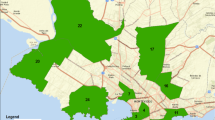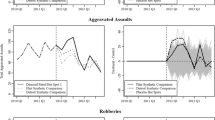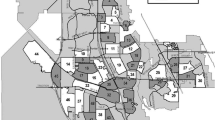Abstract
Objectives
This place-based, randomized experiment explored the impact of different patrol strategies on violent and property crime in microscale predicted crime areas. The experiment aimed to learn whether different but operationally realistic police responses to crime forecasts, estimated by a predictive policing software program, could reduce crime.
Methods
Twenty Philadelphia city districts were randomized to three interventions and one control condition. The three interventions comprised awareness districts (where officers were made aware of predicted areas on roll-call), marked car districts (where a marked patrol police car was dedicated to treatment areas), and unmarked car districts (a plain-clothes vehicle was dedicated to treatment areas). A business-as-usual approach represented the control condition in districts where staff had no access to the predictive software program. Two distinct 3-month phases examined crime outcomes for property and violent crime, respectively.
Results
The marked car treatment showed substantial benefits for property crime (31% reduction in expected crime count), as well as temporal diffusion of benefits to the subsequent 8-h period (40% reduction in expected crime count). No other intervention demonstrated meaningful crime reduction. These reductions were probably not substantial enough to impact city or district-wide property crime. Some violent crime results ran contrary to expectations, but this happened in a context of extremely low crime counts in predicted areas. The small grid size areas hampered achieving statistical power.
Conclusions
The experiment found reductions in property crime resulting from the marked car focused patrols. It also demonstrated the real-world challenges of estimating and preventing crime in small areas.



Similar content being viewed by others
Notes
“Predictive policing…is hot-spot policing, significantly enhanced by technology” [Bill Bratton, NPR interview (Around the Nation), November 26, 2011].
Perry et al. (2013) consolidated these approaches into what they called blended theory, but environmental criminologists usually refer to these as the opportunity theories.
Source: FBI Crime in the US, Table 8 (Offenses known to Law Enforcement by City) and Table 2 (“Crime in the United States, by Community Type, 2015).
While this list includes the variables that were used as inputs to the models, it is important to note that HunchLab used a different model for each crime type. Log files that identified which variables were relevant in predicting each crime type were no longer available at the time this manuscript was drafted due to the transfer of ownership from Azavea to ShotSpotter; therefore, it is unknown how important each of these variables were in generating the forecast for each crime type.
At the request of the police department, we have anonymized the district location information. Therefore, A–E may, or may not, include districts also identified as F–J.
The expected odds = exp((log odds for control district (constant)) + (coefficient for marked condition)), then calculating the expected proportion. The expected proportion is derived as [odds ratio / (1 + odds ratio)]
References
Azavea. (2014). HunchLab: under the hood. Philadelphia: Azavea.
Bowers, K. J., & Johnson, S. D. (2003). Measuring the geographical displacement and diffusion of benefit effects of crime prevention activity. Journal of Quantitative Criminology, 19(3), 275–301.
Box, J. F. (1980). R. A. Fisher and the design of experiments, 1922-1926. The American Statistician, 34(1), 1–7.
Braga, A. A., Papachristos, A., & Hureau, D. (2012). Hot spots policing effects on crime. Campbell Systematic Reviews, report no. 8. Oslo, Norway.
Brantingham, P. L., & Brantingham, P. J. (1981-1982). Mobility, notoriety, and crime: a study in the crime patterns of urban nodal points. Journal of Environmental Systems, 11(1), 89-99.
Browne, W. J. (2012). MCMC estimation in MLwiN. Bristol: University of Bristole Centre for Multilevel Modeling.
Caplan, J. M., Kennedy, L. W., & Miller, J. (2011). Risk terrain modeling: brokering criminological theory and GIS methods for crime forecasting. Justice Quarterly, 28(2), 381.
Chainey, S., & Ratcliffe, J. H. (2005). GIS and crime mapping. London: Wiley.
Chainey, S., Tompson, L., & Uhlig, S. (2008). The utility of hotspot mapping for predicting spatial patterns of crime. Security Journal, 21(1-2), 4–28.
Cohen, L. E., & Felson, M. (1979). Social change and crime rate trends: a routine activity approach. American Sociological Review, 44, 588–608.
Cornish, D., & Clarke, R. (1986). The reasoning criminal: rational choice perspectives on offending. New York: Springer.
Detry, M. A., & Lewis, R. J. (2014). The intention-to-treat principle: how to assess the true effect of choosing a medical treatment. JAMA, 312(1), 85–86.
Drawve, G. (2016). A metric comparison of predictive hot spot techniques and RTM. Justice Quarterly, 33(3), 369–397.
Durlauf, S. N., & Nagin, D. S. (2011). Imprisonment and crime: can both be reduced? Criminology & Public Policy, 10(1), 13–54.
Eck, J. E., Lee, Y. O. S., & Martinez, N. (2017). Compared to what? Estimating the relative concentration of crime at places using systematic and other reviews. Crime Science, 6(8), 1–17.
Felson, M. (1987). Routine activities and crime prevention in the developing metropolis. Criminology, 25(4), 911–932.
Fisher, R. A. (1935). Design of experiments. Edinburgh: Oliver and Boyd.
Flaxman, S., Chiricoz, M., Pereirax, P., & Loeffler, C. (2019). Scalable high-resolution forecasting of sparse spatiotemporal events with kernel methods: a winning solution to the NIJ “real-time crime forecasting challenge”. Annals of Applied Statistics.
Gelman, A., Carlin, J. B., & Stern, H. S. (2003). Bayesian data analysis (2nd ed.). Boca Raton: Chapman & Hall/CRC.
Gilks, W. R., Richardson, S., & Spiegelhalter, D. J. (1996). Introducing Markov chain Monte Carlo. In W. R. Gilks, S. Richardson, & D. J. Spiegelhalter (Eds.), Markov Chain Monte Carlo in practice (pp. 1–20). Boca Raton: Chapman & Hall/CRC.
Gill, C. E., & Weisburd, D. (2013). Increasing equivalence in small-sample, place-based experiments: taking advantage of block randomization methods. In B. C. Welsh, A. A. Braga, & G. J. N. Bruinsma (Eds.), Experimental criminology: prospects for advancing science and public policy (pp. 141–162). Cambridge: Cambridge University Press.
Gorr, W. L., & Lee, Y. (2015). Early warning system for temporary crime hot spots. Journal of Quantitative Criminology, 31(1), 25–47.
Gorr, W. L., Olligschlaeger, A., & Thompson, Y. (2003). Short-term forecasting of crime. International Journal of Forecasting, 19(4), 594.
Greene, J. R. (2014). New directions in policing: balancing prediction and meaning in police research. Justice Quarterly, 31(2), 193–228.
Haberman, C. P., & Ratcliffe, J. H. (2012). The predictive policing challenges of near repeat armed street robberies. Policing: A Journal of Policy and Practice, 6(2), 151–166.
Ignatans, D., & Pease, K. (2016). Taking crime seriously: playing the weighting game. Policing: A Journal of Policy and Practice, 10(3), 184–193.
Johnson, S. D. (2010). A brief history of the analysis of crime concentration. European Journal of Applied Mathematics, 21(4/5), 349–370.
Johnson, S. D., Bowers, K. J., Birks, D., & Pease, K. (2009a). Predictive mapping of crime by ProMap: accuracy, units of analysis and the environmental backcloth. In D. Weisburd, W. Bernasco, & G. J. N. Bruinsma (Eds.), Putting crime in its place: units of analysis in geographic criminology (pp. 171–198). New York: Springer.
Johnson, S. D., Summers, L., & Pease, K. (2009b). Offender as forager? A direct test of the boost account of victimization. Journal of Quantitative Criminology, 25(2), 181–200.
Kennedy, L. W., Caplan, J. M., & Piza, E. (2011). Risk clusters, hotspots, and spatial intelligence: risk terrain modeling as an algorithm for police resource allocation strategies. Journal of Quantitative Criminology, 27(3), 362.
Koper, C. S. (1995). Just enough police presence: reducing crime and disorderly behavior by optimizing patrol time in crime hot spots. Justice Quarterly, 12(4), 649–672.
Lee, Y. O. S., & Eck, J. E. (2017). A theory-driven algorithm for real-time crime hot spot forecasting. National Institute of Justice: Final report. Washington DC.
Lum, C., & Nagin, D. S. (2017). Reinventing American policing. Crime and Justice, 46(1), 339–393.
Moher, D., Hopewell, S., Schulz, K. F., Montori, V., Gøtzsche, P. C., Devereaux, P. J., et al. (2010). CONSORT 2010 explanation and elaboration: updated guidelines for reporting parallel group randomised trials. British Medical Journal, 340(c869), 1–28.
Mohler, G. O., Short, M. B., Brantingham, P. J., Schoenberg, F. P., & Tita, G. E. (2011). Self-exciting point process modeling of crime. Journal of the American Statistical Association, 106(493), 108.
Moreto, W. D., Piza, E. L., & Caplan, J. M. (2014). “A plague on both your houses?”: risks, repeats and reconsiderations of urban residential burglary. Justice Quarterly, 31(6), 1102–1126.
National Research Council. (2004). Fairness and effectiveness in policing: the evidence (Editors: Wesley Skogan and Kathleen Frydl). Committee to Law and Justice. Washington: Division of Behavioral and Social Sciences and Education.
Perry, W. L., McInnis, B., Price, C. C., Smith, S. C., & Hollywood, J. S. (2013). Predictive policing: the role of crime forecasting in law enforcement operations. Washington: Rand Corporation.
Ratcliffe, J. H. (2000). Aoristic analysis: The spatial interpretation of unspecific temporal events. International Journal of Geographical Information Science, 14(7), 669–679.
Ratcliffe, J. H. (2014). What is the future... of predictive policing? Translational Criminology, 2014(Spring), 4–5.
Ratcliffe, J. H. (2015a). Harm-focused policing. In Ideas in American Policing (19). Washington: Police Foundation.
Ratcliffe, J. H. (2015b). Towards an index for harm-focused policing. Policing: A Journal of Policy and Practice, 9(2), 164–182.
Ratcliffe, J. H., & McCullagh, M. J. (1998). Aoristic crime analysis. International Journal of Geographical Information Science, 12(7), 751–764.
Ratcliffe, J. H., & Rengert, G. F. (2008). Near repeat patterns in Philadelphia shootings. Security Journal, 21(1-2), 58–76.
Ratcliffe, J. H., Taniguchi, T., Groff, E. R., & Wood, J. D. (2011). The Philadelphia foot patrol experiment: a randomized controlled trial of police patrol effectiveness in violent crime hotspots. Criminology, 49(3), 795–831.
Ratcliffe, J. H., Taylor, R. B., & Fisher, R. (in press). Conflicts and congruencies between predictive policing and the patrol officer’s craft. Policing and Society.
Rummens, A., Hardyns, W., & Pauwels, L. (2017). The use of predictive analysis in spatiotemporal crime forecasting: building and testing a model in an urban context. Applied Geography, 86, 255–261.
Saunders, J., Hunt, P., & Hollywood, J. S. (2016). Predictions put into practice: a quasi-experimental evaluation of Chicago’s predictive policing pilot. Journal of Experimental Criminology, 12(3), 347–371.
Sherman, L. W. (2007). The power few: experimental criminology and the reduction of harm. Journal of Experimental Criminology, 3(4), 299–321.
Sherman, L. W., & Weisburd, D. (1995). General deterrent effects of police patrol in crime “hot spots”: a randomized, controlled trial. Justice Quarterly, 12(4), 625–648.
Sherman, L. W., Gartin, P., & Buerger, M. E. (1989). Hot spots of predatory crime: routine activities and the criminology of place. Criminology, 27(1), 27–55.
Sherman, L. W., Williams, S., Ariel, B., Strang, L. R., Wain, N., Slothower, M., & Norton, A. (2014). An integrated theory of hot spots patrol strategy: implementing prevention by scaling up and feeding back. Journal of Contemporary Criminal Justice, 30(2), 95–112.
Sherman, L. W., Neyroud, P. W., & Neyroud, E. (2016). The Cambridge crime harm index: measuring total harm from crime based on sentencing guidelines. Policing: A Journal of Policy and Practice, 10(3), 171–183.
Sorg, E. T., Haberman, C. P., Ratcliffe, J. H., & Groff, E. R. (2013). Foot patrol in violent crime hot spots: longitudinal impacts of deterrence and post-treatment effects of displacement. Criminology, 51(1), 65–101.
Summers, L., & Rossmo, D. K. (2019). Offender interviews: Implications for intelligence-led policing. Policing: An International Journal, 42(1), 31–42.
Taylor, R. B. (1994). Research methods in criminal justice. New York: McGraw-Hill.
Taylor, R. B., & Ratcliffe, J. H. (2019). Is the Pope’s visit to blame, or something else?: statistical power, the lack thereof, and nano-scale predictive policing randomized control trials. Paper presented at the annual meetings of the American Society of Criminology. San Francisco: November.
Taylor, B., Koper, C. S., & Woods, D. J. (2011). A randomized controlled trial of different policing strategies at hot spots of violent crime. Journal of Experimental Criminology, 7(2), 149–181.
Tompson, L., & Townsley, M. (2010). (Looking) Back to the future: using space–time patterns to better predict the location of street crime. International Journal of Police Science and Management, 12(1), 23–40.
Tseloni, A., & Pease, K. (2003). Repeat personal victimization: ‘boosts’ or ‘flags’? British Journal of Criminology, 43(1), 196–212.
Weisburd, D., & Eck, J. (2004). What can police do to reduce crime, disorder, and fear? The Annals of the American Academy of Political and Social Science, 593(1), 43–65.
Weisburd, D., & Green, L. (1995). Measuring immediate spatial displacement: methodological issues and problems. In J. E. Eck & D. Weisburd (Eds.), Crime and place (Vol. Volume 4, pp. 349-361). Monsey: Criminal Justice Press.
Weisburd, D., & Telep, C. (2014). Hot spots policing: what we know and what we need to know. Journal of Contemporary Criminal Justice, 30(2), 200–220.
Weisburd, D., Groff, E. R., Jones, G., Cave, B., Amendola, K. L., Yang, S.-M., & Emison, R. F. (2015). The Dallas patrol management experiment: can AVL technologies be used to harness unallocated patrol time for crime prevention? Journal of Experimental Criminology, 11(3), 367–391.
Wyant, B. R., Taylor, R. B., Ratcliffe, J. H., & Wood, J. (2012). Deterrence, firearm arrests, and subsequent shootings: a micro-level spatio-temporal analysis. Justice Quarterly, 29(4), 524–545.
Funding
This research was made possible by award number 2014-R2-CX-0002 from the National Institute of Justice.
Author information
Authors and Affiliations
Corresponding author
Ethics declarations
Conflict of interest
Any views or opinions expressed herein do not necessarily reflect the official policies of the Department of Justice, the National Institute of Justice, the Philadelphia Police Department, or the City of Philadelphia. Any mention of trade names, commercial practices, or organizations does not imply endorsement by the Department of Justice, the National Institute of Justice, the Philadelphia Police Department, or the City of Philadelphia. None of the authors has any financial investment in Azavea, Inc. or ShotSpotter Inc., and none of the authors has received any financial or other incentive from either company related to the HunchLab product.
Additional information
Publisher’s note
Springer Nature remains neutral with regard to jurisdictional claims in published maps and institutional affiliations.
Electronic supplementary material
ESM 1
(PDF 385 kb)
Rights and permissions
About this article
Cite this article
Ratcliffe, J.H., Taylor, R.B., Askey, A.P. et al. The Philadelphia predictive policing experiment. J Exp Criminol 17, 15–41 (2021). https://doi.org/10.1007/s11292-019-09400-2
Published:
Issue Date:
DOI: https://doi.org/10.1007/s11292-019-09400-2




